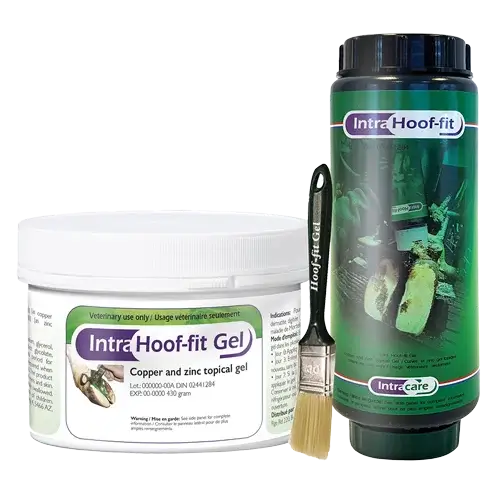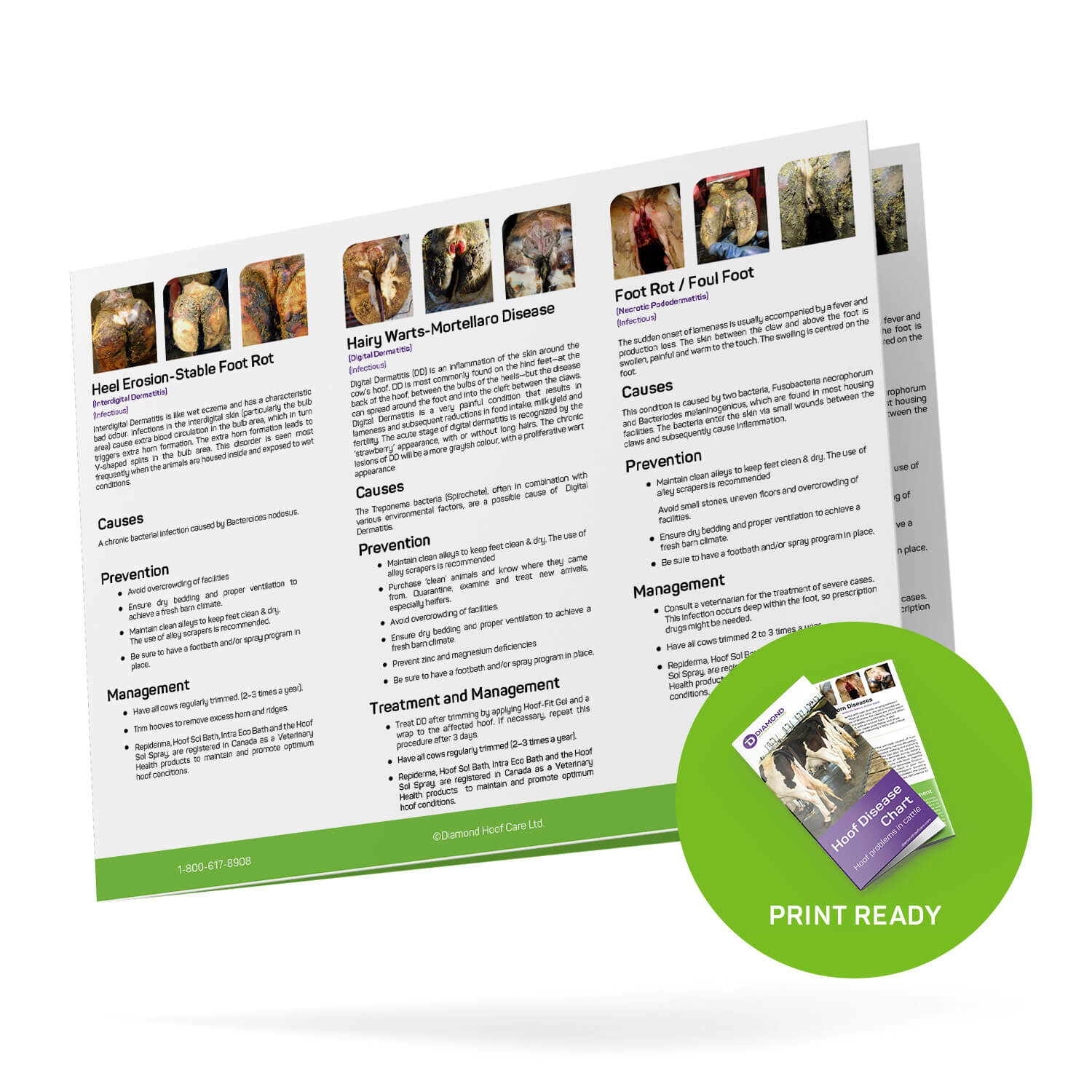About Digital Dermatitis
Digital dermatitis (DD), also known as Mortellaro Disease or Italian footrot, is an inflammation of the skin around the cow’s hoof. The disease was discovered in the early 1970s by an Italian veterinarian, Dr. Mortellaro.
It is most commonly found on the hind feet, more specifically at the back of the hoof, and between the bulbs of the heels. The disease can spread around the foot and into the cleft between the claws. It is also characterized as being a very painful condition that results in lameness. This consequently reduces food intake, milk yield, and fertility.
While the acute stage of digital dermatitis is recognized by a ‘strawberry’ appearance, either with or without long hairs, the chronic lesions of digital dermatitis will be a more grayish colour with a proliferative wart appearance.
What is Digital Dermatitis in cows?
Open and sore spots on a cow’s foot are commonly referred to as hairy warts or Mortellaro’s disease. These spots can be very painful and are contagious. This consequently reduces food intake, milk yield, and fertility. How are these spots treatable and preventable?
Digital dermatitis (DD), sometimes called Mortellaro Disease, Italian footrot, Strawberry foot or Hairy wart, is an inflammation of the skin around the cow’s hoof. It is most commonly found on the hind feet, more specifically at the back of the hoof and between the bulbs of the heels. The disease can spread around the foot and into the cleft between the claws.
It is characterized as being a very painful condition that results in lameness. While the acute stage of digital dermatitis is recognized by a ‘strawberry’ appearance, either with or without long hairs, the chronic lesions of digital dermatitis will be a more grayish color with a proliferative wart appearance. Read on to learn more about treating this hoof disease.
What causes Digital Dermatitis?
Digital dermatitis is most commonly caused by the spirochaete bacteria of the Treponema genus. The Treponema organisms are characterized by their long but thin shape with a fine, hair-like filament along their length.
Furthermore, treponemas are able to penetrate deep into the skin of the bovine foot, after which they spread and colonize within skin cells. This is why affected cows show more pain during the early stages of the infection.
How are the DD Lesions Classified?
Worldwide we use the classification that was originally developed by Döpfer et al. (1997) and extended by Berry et al. (2012). Below you will find the summary of the classes for DD:




How does Digital Dermatitis transmit between cows?
The spreading is through contact with the DD bacteria in, for example, manure. There is also a potential for spreading the disease through the improper use of foot baths, whereby they become rather an infection factor than a prevention solution. The DD bacteria is also believed to cause similar hoof problems in elk and sheep.
In addition, this hoof problem is a high-cost problem in dairy herds. In my career as a trimmer, I have also seen an increase in feedlots. These farms often purchase cows from auction sales, and they are transported on cattle liners, where potential spreading could happen.
Döpfer et al. found that the M2 and the M4 lesions were infectious, and the M2 is on average twice as infectious as the M4.
What location on the hoof do we find Digital Dermatitis?
The lesions are most common on the skin of the heels of cattle. That being said, it also occurs in between the two claws (inter-digital space) and the front of the hoof, along the coronary band. Spirochaete bacteria have also been found on sole ulcers and toe necrosis.
There remain many questions regarding its transmission and the effect of DD on other hoof diseases.
How do we treat Digital Dermatitis?
This disease is relatively easy to treat if it is caught on time. In my early career as a hoof trimmer, I used Tetra 1000 mixed with an iodine cream. Since 2006 I went 100% antibiotic-free by using the Hoof-fit Gel to treat Digital Dermatitis. Extensive trials in The Netherlands and Canada have proven that the Hoof-fit Gel is 1.58 times more effective than conventional antibiotic treatments.
The protocol is very easy – I have made a video to show the steps:
- Trim the cow regularly to keep her hooves in optimal condition.
- Dry the skin of the hoof – in between and in the backside – by using a paper towel or hand towel.
- Brush the Hoof-fit Gel in between and on the back of the hoof.
- Apply a wrap – on the severe cases – and leave this on for 3-4 days.
- Some cows need a second brushing with the gel, but now without a wrap.
Dr. Menno Holzhauwer from the Dutch Animal Health Service and Mr. Pieter Kloosterman, trainer at the Hoof Trimming Training Center, explain the use of no-antibiotic products in this video. In Canada, the Hoof-fit Gel is registered by Health Canada with a DIN number. Safety and efficacy have been proven, which are two requirements for any product used on our farms.

Hoof-fit Gel
How can we prevent Digital Dermatitis?
A clean and dry environment with ample ventilation will definitely help to manage all hoof-related problems. Additionally, if possible, reduce the risk of ‘buying in’ the disease by simply not purchasing cows from anywhere or ensure that you will be getting ‘DD-clean cows’.
Commonly products like copper and formalin were used in footbaths on dairy farms. Farmer safety, environmental impact, and unproven efficacy have been reasons to choose alternative options and products.
Lastly, for my dairy clients, we use safe and effective hoof bath products as part of a total hoof health protocol. Weekly hoof spraying sessions with Intra Hoof Sol Spray have also been an effective method in our protocol.
